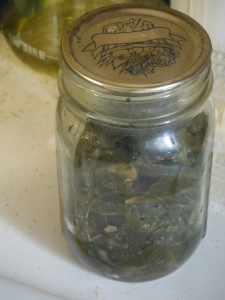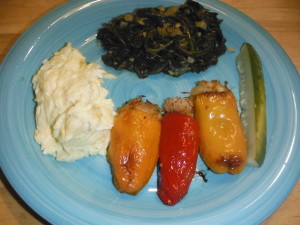About a week ago, we ran across a dusty old jar or collards greens that we pressure canned ourselves…about 5-6 years ago. It had somehow got pushed to the back of the cabinet, and was overlooked all this time.
 We opened it and ate it for dinner that night.
We opened it and ate it for dinner that night.
Here is a picture of it.
I have a three part test I put all canned good through before consuming them. Looking closely at the lid, you’ll notice some rust. Luckily, it was surface rust only, and had not compromised the integrity of the jar. Or, in Hillbilly-speak, “The jar was still sealed”. That is the first test of home canned goods:
1. Is the seal intact?
Next is the smell test. I opened it and sniffed. It smelled like collards, not like death, thus passing test number 2:
2. Does it smell bad?
It still looked like collards, not like something had decomposed, with normal colors and textures, passing the final test I put it through:
3. Does it look like it did originally?
So we browned some garlic and onions, tossed in the collards to heat them up. Since pressure canning pre-cooks everything, there was no reason to cook it more than to heat it through.
 It them became the side dish for our garlic squash, chicken stuffed peppers, and a spear of my two day fridge pickles, all seen here. The peppers were from the green market, selected from the peppers I bought to dehydrate. The chicken was from store bought canned chicken we stock up on. (I just as easily could have used the canned chicken I put up myself.) The squash and cucumbers for the pickles were also from the green grocer, since squash and cucumber have not done well for me. Everything was either fresh, or from our long term storage.
It them became the side dish for our garlic squash, chicken stuffed peppers, and a spear of my two day fridge pickles, all seen here. The peppers were from the green market, selected from the peppers I bought to dehydrate. The chicken was from store bought canned chicken we stock up on. (I just as easily could have used the canned chicken I put up myself.) The squash and cucumbers for the pickles were also from the green grocer, since squash and cucumber have not done well for me. Everything was either fresh, or from our long term storage.
Home cooked food…and we eat like this more often than not….and 5 year old collard greens were a part of it. Efforts I made to store some freshness from our garden paid off after half a decade.
Now, 5 years is far beyond what the Extension Agent would tell you….they’d say a year or less shelf life, with extreme cases reaching 24 months.
I’m going to side with Penn Jillette when he cries “BULLSHIIT!“
I know the Extension offices have to err on the side of caution….but this is ridiculous. And sometimes they can get downright insulting.
For instance, this is actually on the Utah State University website:
You sanctimonious bastards! I guess this proves who writes the grant checks, eh? So a bulk factory with an allowable “2 or more maggots per 100 grams, in a minimum of 12 subsamples” in their tomato juice is able to provide a better product than someone in their own kitchen following the very guidelines that the extension offices wrote? Give me a break!
I don’t know about you, but if I were making tomato juice to can, and I ran across a single maggot in the juice as I was about to process…and I’d throw the whole batch out into the compost or to the chickens. I’m not saying that a maggot or two is going to kill me, I’m saying that I care FAR more about my products than a factory worker does.
(Sorry to have gone off on a rant, you should know it is going to happen from time to time here…)
Back to my canned collards. They were mighty tasty. We didn’t get sick. And none of us ran across any maggots while we were eating the collards. So I’ll stick to my belief that home canned goods are at LEAST as good, and probably a lot better than a factory processed product. And that they last ten or more years if processed and stored properly in a dark, dry environment.
But then what do I know, I’m just a dislocated hillbilly with only a high school education….. that just happens to be from a long line of people that have been canning their food for probably close to a century by now. I’ve heard of no deaths in the family due to home canned goods…
I know how I plan on dealing with a 5 year old jar of canned collards, if I run across another…
How about you?
Peace,
db
As always, please “like” FloridaHillbilly on Facebook, subscribe to my feed, follow me on Twitter, add it to Google+, Pinterest, Linkdn, Digg, and/or tell your friends! The more folks we can get to pull their heads out of the sand (or other dark places!), the better this country will become. Let’s not waste what our Founding Fathers did for us all those years ago.
Need something from Amazon (and who doesn’t)? I earn a small commission from purchases made when you begin your Amazon shopping experience here. You still get great Amazon service and your price is the same, no matter what.
Somebody gets the referral fee, why not allow this old Hillbilly use it to help make ends meet?
db if you have a problem growing squash, try growing chayote. easy to grow and is perennial. we harvested over 100 fruit from our 3 year old vine so far this year, and expect another crop from it this fall. just a thought.
Bob
I’d imagine a bit of Tabasco/hot sauce on them there collards would hit the spot.
You know it!
can you send me your collards canning AND how you did it I would like to try it this. I do a lot of canning but not on collards or spinach. I was told not to do it but I see you can. need HELP. thank you for your in put.
Canning low acid foods, such as spinach or collards, requires a pressure canner.
If you pick up a copy of the Ball Blue Book of Canning, you’ll find all your questions (and more!) answered.
db
thank you sooo much for your help on canning Green’s I got the ball jars book :0 now I have been doing up bone broth. love it. I hope you keep up on letting us know. how thing are going down there.